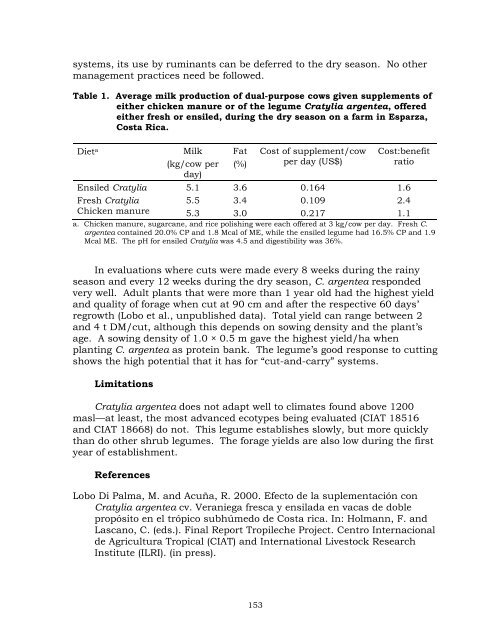Feeding Systems with Legumes to Intensify Dairy Farms - cgiar
Feeding Systems with Legumes to Intensify Dairy Farms - cgiar
Feeding Systems with Legumes to Intensify Dairy Farms - cgiar
Create successful ePaper yourself
Turn your PDF publications into a flip-book with our unique Google optimized e-Paper software.
systems, its use by ruminants can be deferred <strong>to</strong> the dry season. No other<br />
management practices need be followed.<br />
Table 1. Average milk production of dual-purpose cows given supplements of<br />
either chicken manure or of the legume Cratylia argentea, offered<br />
either fresh or ensiled, during the dry season on a farm in Esparza,<br />
Costa Rica.<br />
Dieta Milk<br />
(kg/cow per<br />
day)<br />
Ensiled Cratylia 5.1<br />
Fresh Cratylia<br />
5.5<br />
Chicken manure 5.3<br />
Fat<br />
(%)<br />
153<br />
Cost of supplement/cow<br />
per day (US$)<br />
Cost:benefit<br />
ratio<br />
3.6<br />
0.164<br />
1.6<br />
3.4<br />
0.109<br />
2.4<br />
3.0<br />
0.217<br />
1.1<br />
a. Chicken manure, sugarcane, and rice polishing were each offered at 3 kg/cow per day. Fresh C.<br />
argentea contained 20.0% CP and 1.8 Mcal of ME, while the ensiled legume had 16.5% CP and 1.9<br />
Mcal ME. The pH for ensiled Cratylia was 4.5 and digestibility was 36%.<br />
In evaluations where cuts were made every 8 weeks during the rainy<br />
season and every 12 weeks during the dry season, C. argentea responded<br />
very well. Adult plants that were more than 1 year old had the highest yield<br />
and quality of forage when cut at 90 cm and after the respective 60 days’<br />
regrowth (Lobo et al., unpublished data). Total yield can range between 2<br />
and 4 t DM/cut, although this depends on sowing density and the plant’s<br />
age. A sowing density of 1.0 × 0.5 m gave the highest yield/ha when<br />
planting C. argentea as protein bank. The legume’s good response <strong>to</strong> cutting<br />
shows the high potential that it has for “cut-and-carry” systems.<br />
Limitations<br />
Cratylia argentea does not adapt well <strong>to</strong> climates found above 1200<br />
masl—at least, the most advanced ecotypes being evaluated (CIAT 18516<br />
and CIAT 18668) do not. This legume establishes slowly, but more quickly<br />
than do other shrub legumes. The forage yields are also low during the first<br />
year of establishment.<br />
References<br />
Lobo Di Palma, M. and Acuña, R. 2000. Efec<strong>to</strong> de la suplementación con<br />
Cratylia argentea cv. Veraniega fresca y ensilada en vacas de doble<br />
propósi<strong>to</strong> en el trópico subhúmedo de Costa rica. In: Holmann, F. and<br />
Lascano, C. (eds.). Final Report Tropileche Project. Centro Internacional<br />
de Agricultura Tropical (CIAT) and International Lives<strong>to</strong>ck Research<br />
Institute (ILRI). (in press).
















